

Turban Snail. Overview The Turban Snail is a powerhouse that helps keep live rock and aquarium glass free of algae.

This peaceful snail boasts an interesting shell and is a smart addition to your existing aquarium cleanup crew. The Turban Snail, is also known as the Top Snail, False Trochus Snail, or Pyramid Snail, and is found in holes and crevices of the reef in the Indo-Pacific Ocean. It has a bumpy shell shaped like a top or turban generally in varying earth tone colors including white, tan or even brown. The foot of the snail is white with fine black dots. This hardy snail does well in an established aquarium with ample places to hide. Banded Trochus Snail. Overview The Banded Trochus Snail is touted by aquarists of all experience levels for numerous reasons.
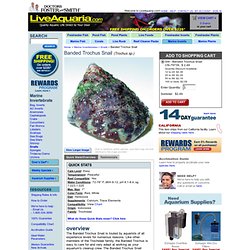
Like other members of the Trochidae family, the Banded Trochus is easy to care for and very adept at working as your aquarium's cleanup crew. The Banded Trochus Snail normally has a black foot that is an off white/tan color on the underside of the foot. It boasts a pale gray, top- or pyramid-shaped shell. Thanks to the maroon stripes or bands on its shell, the Banded Trochus Snail adds a unique flair to any marine system.
Crocea. Crocea Clams, Tridacna Crocea, Boring Clam, Crocus Clam With Clam Facts About Giant Clams and Pictures of Clams. Tridacna crocea, the Crocea Clams, are some of the most colorful members of the giant clams!
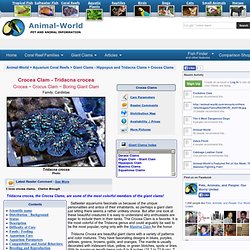
Saltwater aquariums fascinate us because of the unique personalities and antics of their inhabitants, so perhaps a giant clam just sitting there seems a rather unlikely choice. But after one look at these beautiful creatures it is easy to understand why enthusiasts are eager to include them in their tanks. By Barry Neigut. A Brief Guide to the Selection and Placement of Tridacnid Clams By Barry Neigut barry@clamsdirect.com.
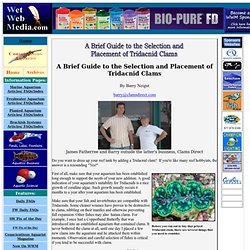
Crocea Clam - Tridacna Crocea Clam. The Crocea Clam is an absolutely amazing looking saltwater clam.

The Crocea Clam usually costs anywhere from $30 to $100 dollars depending on your location. In general, there are several different species of Tridacna clams available. There is the T. maxima which gets to be about 12 inches. The T. derasa which gets even bigger than the maxima. Then comes the Tridacna crocea which stays smaller, usually only growing to about 6 inches (15 cm). For standard sized and shallow tanks you may be able to keep these Crocea Clams with power compacts with multiple bulbs. Crocea Clams are also filter feeders and will feed on dissolved nutrients in the water column.
Placing your Crocea Clam is important and you don't want to be moving it around all the time. Crocea Clam (Tridacna crocea) Tridacna crocea are beautiful clams oftentimes displaying a variety of colorations with intricate patterns.
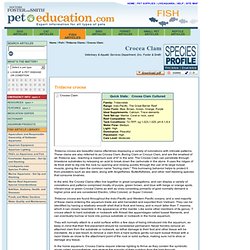
These clams are also referred to as Crocea Clam, Boring Clam or Crocus Clam, and are the smallest of all Tridacna spp., reaching a maximum size of 6" in the wild. The Crocea Clam can penetrate through limestone substrates by releasing an acid to break down the carbonate in the stone. It uses the ridges of its thick shell to dig into the rock by opening and closing quickly through the use of its large byssal muscle, giving the clam the common name "boring clam. " This burrowing behavior helps to protect it from predators such as sea stars, along with Angelfishes, Butterflyfishes, and other reef dwelling species that consume bivalves. Clam FAQ!! - The Reef Tank. Phyto and Clams: In the first post of this thread it was suggested that Phyto be fed to Maxima clams,..
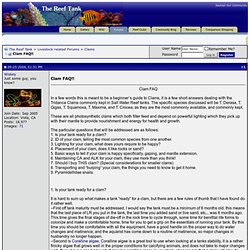
But it is a long held hobby myth that any clam under 3" should be fed Phyto, by means of the boal feeding method, or by puting a container over the clam and injecting phyto into the container,.. or more simply feeding it directly to the tank. There are certainly plenty of phyto supplements out there,.. and it is proven that clams do eat phyto, but do they need it?
Why do we care? Phyto is not something I want to add to my tank,.. it's loaded with phosphate (anyone looked up how they make this stuff? ) and with the exception of some feather dusters and sponges and such almost nothing eats it directly. Also, phyto is naturally occurring in our tanks,... anyone that has skimmed wet has probably come up with a green skimate,.. that's phyto at least in part. Saltwater Aquarium Crabs for Marine Reef Aquariums: Electric Blue Hermit Crab. Overview The Electric Blue Hermit Crab, a very rare find, originates exclusively from the Marshall Islands.
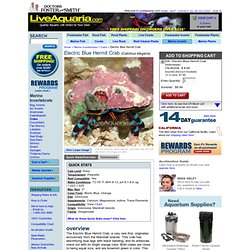
This crab has electrifying blue legs with black banding, and its antennae stand out with its bright orange color. Both claws are close to being equal size, and are brownish green in color. Electric Blue Hermit Crab. Overview The Electric Blue Hermit Crab, a very rare find, originates exclusively from the Marshall Islands.

This crab has electrifying blue legs with black banding, and its antennae stand out with its bright orange color. Both claws are close to being equal size, and are brownish green in color. Saltwater aquarium crabs: Arrow , Emerald, Scarlet Hermit, Sallylightfoot, Blueleg, Porcelain, Decorator, Anemone, Horseshoe. Arrow Crab with its long body and arrow like head is also known as the Spider Crab.

An extremely hardy species that will be a long time inhabitant, different species are found throughout the world but the species we offer is a well known caribbean invertebrate that is one of the BEST reef scavengers ot there. They will consume all decaying or left over foods, as well as prey on bristle and flat worms which makes them highly sought after for nuisance control in any reef aquarium. If the tank is extremely clean where insufficient food may be a problem, place a sheet of green algae in the reef tank with a rubber band around a piece of rock.
Hermit Crab - Clibanarius spp. Hermit Crab Information - There are a lot of different types of Hermit Crabs available but some are better than others in a marine aquarium. If you are looking for something to add to your clean up crew, check out the blue-legged and red-legged hermit crab varieties. They will scavenge all over your live rock and sand substrate looking for algae and detritus. It has been reported that the red leg hermit will eat cyanobacteria, which is red slime algae. If you have a relatively new tank you may want to supplement their diet with dried seaweed to prevent them from starving. You will also want to get some extra hermit crab shells of different sizes for them to move in to as they grow. Longspine Urchin, Black. Overview The Black Longspine Urchin, also known as Long-spined Sea Urchin, has a body which is predominately black with a red eyespot in the center. The spines on these urchins are long, thin and completely black.
They are a very delicate looking urchin, which are actually very capable of protecting itself. These urchins are excellent algae controllers for an aquarium housing aggressive fish. Provide an aquarium with ample hiding places and room to roam. It is very sensitive to high levels of copper-based medications and will not tolerate high nitrate levels. Blue Tuxedo Urchin. Overview The Blue Tuxedo Urchin, also known as the Sphere Urchin or Globe Urchin, has five to ten broad-colored bands usually blue or black, with red, brown, or dark spines. This very striking combination, gives it the "formal" look and thus the name "Tuxedo Urchin. " During the day, it will hide among the rocks, in crevices, or under plants in a sandy substrate.
At night, it will emerge to graze on the algae present in or near its home. The Tuxedo Pincushion Urchin generally roams alone, but several of them could be housed in the same aquarium if it is large enough to provide them with adequate food (algae) and shelter. If algae levels are particularly low, its diet will need to be supplemented with dried seaweed. Approximate Purchase Size: Small 1-1/2" to 2" Medium 2" to 3"